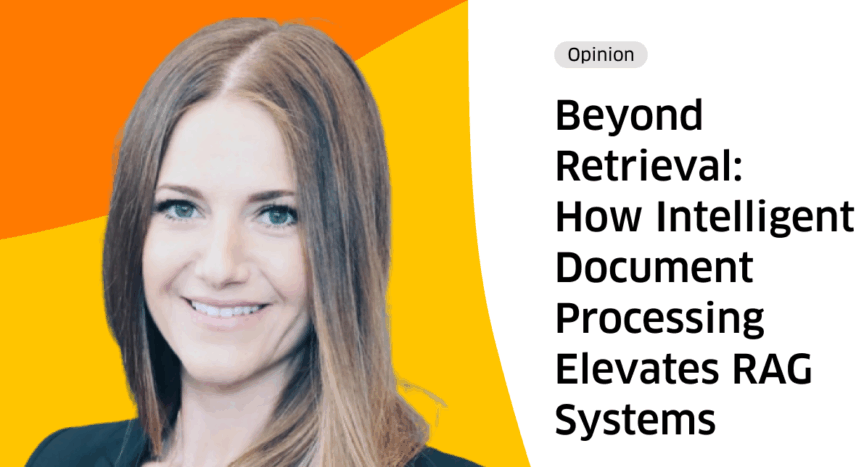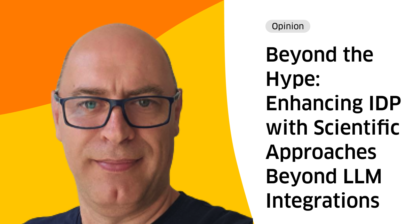Curious about what keeps experts, CEOs and other decision-makers in the Intelligent Document Processing (IDP) space on their toes? Get food for thought on IDP-related topics from the industry’s leading minds.
In this opinion piece, Dr. Marlene Wolfgruber, Product Marketing Lead for AI at Intelligent Document Processing (IDP) vendor ABBYY, explains that while Retrieval-Augmented Generation (RAG) has brought some breakthroughs for enterprises in scaling automation, it’s also revealed a few cracks beneath the surface – and why that’s exactly where Intelligent Document Processing (IDP) comes into play.
When Retrieval-Augmented Generation (RAG) entered the spotlight, it offered a compelling promise: smarter, more reliable large language model (LLM) outputs, grounded in real-world data. It was a major leap forward in AI application design—especially for enterprises looking to scale automation and insight generation.
But while RAG has delivered some breakthroughs, it’s also revealed a few cracks beneath the surface.
Enterprises adopting RAG quickly run into recurring challenges: hallucinated outputs, irrelevant results, and inconsistent comprehension. And the root cause is clearer than ever—most RAG systems are only as good as the data they retrieve. If the inputs are messy, incomplete, or unstructured, the outputs will reflect that.
That’s where Intelligent Document Processing (IDP) comes in. It’s not just a companion to RAG—it’s the missing infrastructure.
What’s Holding RAG Back?
RAG enhances LLMs by pulling from curated knowledge sources, bridging the gap between generative fluency and factual accuracy. But even high-end deployments often struggle with:
- Hallucinations: LLMs can confidently generate factually incorrect answers—even with retrieval in the loop.
- Noisy retrievals: Outdated or irrelevant documents are often pulled into context, skewing results.
- Contextual blind spots: Even when the right data is retrieved, nuances get lost if the context isn’t well understood.
Why does this happen? Because much of enterprise data—contracts, reports, emails, PDFs—is unstructured or semi-structured. Traditional data processing pipelines, built around keyword extraction or basic OCR, just aren’t built for the complexity of real-world documents.
IDP: The Missing Link in the RAG Stack
Intelligent Document Processing offers a smarter foundation. It’s a set of AI-powered capabilities that turn messy, fragmented document data into structured, contextual knowledge—ready for consumption by RAG systems.
Think of IDP as the upstream layer that ensures your LLM is retrieving the right information, in the right format, at the right time.
5 Ways IDP Supercharges RAG
1. High-Fidelity Data Extraction
While basic OCR might recognize text, IDP understands it. By combining OCR with natural language processing and machine learning, IDP extracts data with contextual awareness. That means richer, more complete datasets feeding into RAG pipelines.
2. Semantic Chunking for Smarter Retrieval
Instead of dividing documents arbitrarily, IDP breaks them down into meaningful “chunks” based on actual content. This enables RAG systems to pull highly targeted, semantically relevant answers.
3. Contextual Understanding, Built-In
IDP goes beyond text—it identifies key entities, relationships, and sentiment across documents. That means when RAG retrieves a paragraph, it understands the broader context, not just isolated phrases.
4. Structuring the Unstructured
Most enterprise knowledge lives in formats that machines struggle with—scanned documents, emails, or disjointed PDFs. IDP turns all of that into a structured, searchable knowledge base that RAG can reliably pull from.
5. Metadata That Actually Matters
Search precision improves dramatically with rich metadata. IDP auto-generates metadata that reflects the document’s true meaning and intent—fueling smarter, faster retrieval for LLMs.
What’s the Cost of Skipping IDP?
Many teams underestimate the downstream impact of poor document processing. But the effects ripple throughout the business:
- Operational drag: Manual reviews and rework slow down workflows.
- Compliance gaps: Missed details can lead to regulatory exposure.
- Loss of confidence: Users stop trusting the system when answers are unreliable.
The fix isn’t just upgrading your RAG model—it’s improving the foundation it sits on.
RAG + IDP in Action: Industry Examples
Healthcare
Unstructured patient notes, research papers, and treatment histories are processed by IDP. RAG then retrieves this structured data alongside current medical research to generate personalized treatment insights fast.
Legal
IDP parses dense contracts, regulations, and case law. RAG delivers instant summaries, clause comparisons, or relevant precedents—saving teams hours of manual research.
Supply Chain
Invoices, shipping docs, and supplier emails are transformed into structured data by IDP. RAG uses this to forecast demand, flag risks, or recommend procurement actions in real time.
A New Standard for Enterprise AI
The next generation of AI isn’t just about better models—it’s about better data. And that starts with IDP.
As organizations continue to embrace LLMs and RAG for decision support and automation, the need for clean, structured, context-aware document data will only grow. IDP makes that possible—at scale.
Ready to Level Up Your RAG Strategy?
Don’t just retrieve. Understand. With IDP and RAG, the future of enterprise intelligence is already here.

About the Author
Dr. Marlene Wolfgruber is the Product Marketing Lead for AI at ABBYY, bringing over 10 years of leadership experience in product management and marketing. She has deep knowledge in a wide range of topics within the intelligent automation industry, and regularly shares her expertise as an expert in AI and language technologies. In her previous roles, Wolfgruber led efforts to revolutionize AI-powered spend management and empowered businesses to build autonomous Opinion Piece by Dr. Marlene Wolfgruber, Product Marketing Lead for AI at Intelligent Document Processing (IDP) vendor ABBYY.assistants with generative AI. Wolfgruber holds a Ph.D. in computational linguistics from Ludwig Maximilian University of Munich, and enjoys reading, exercising, cooking, and spending time with her two children.
To find more news from ABBYY, click here.
You may also be interested in:
What Are AI Agents Really? A Closer Look at the Next Frontier in Automation

📨Get IDP industry news, distilled into 5 minutes or less, once a week. Delivered straight to your inbox ↓







